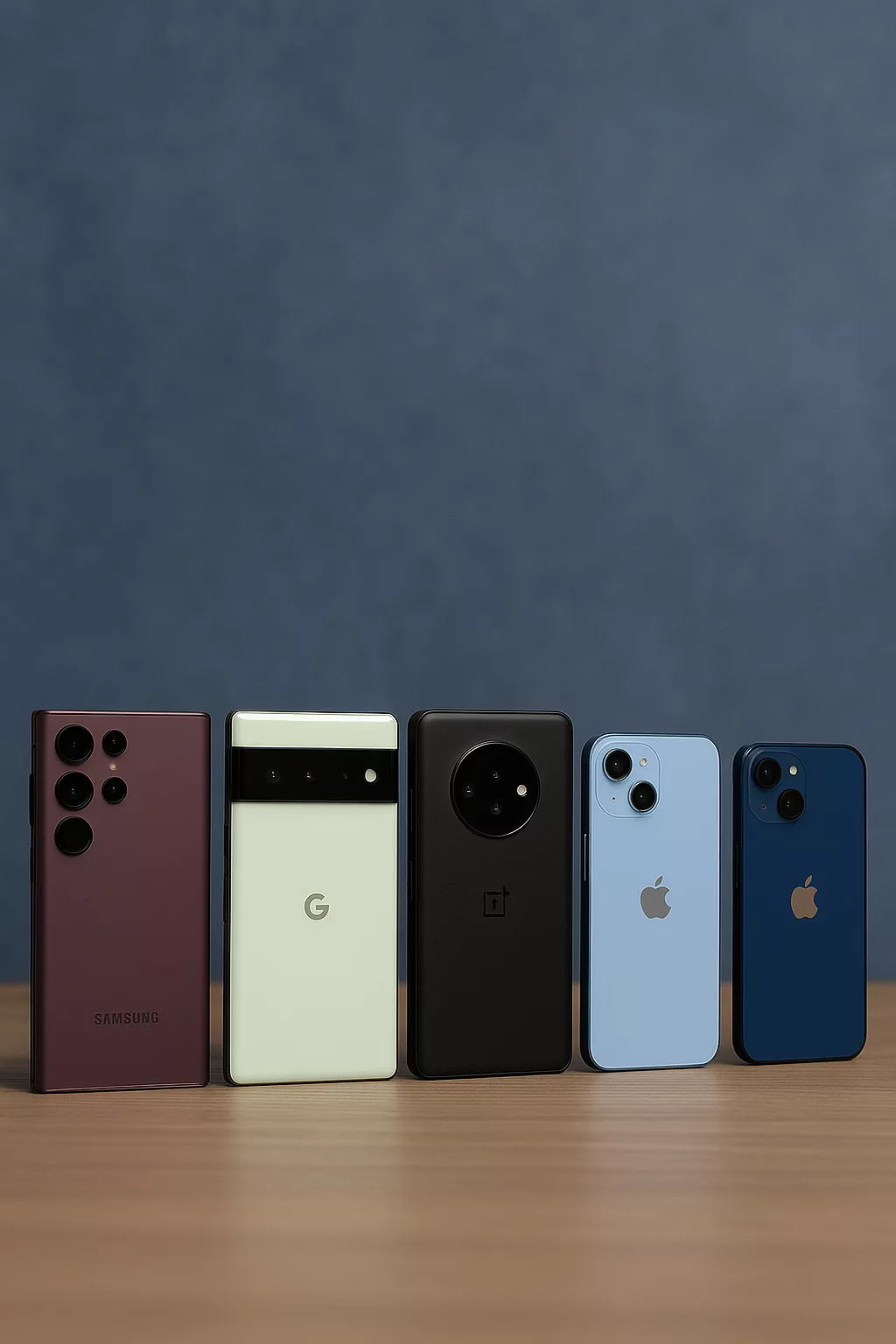
Finding a good phone under $300 feels a lot easier in 2025 than it did a few years ago. Manufacturers keep pushing quality and features down into lower price brackets, and now I see real value even in entry level and midrange models. Whether I’m looking for a dependable daily driver, a backup phone, or that perfect device for a family member, there are options that balance performance, battery life, and design without breaking the bank.
I’ve been testing a wide range of phones in this price range, using them for everyday activities like browsing, streaming, social media, games, and work. Having spent plenty of hands-on time with these devices, I can point out where each one shines and where it’s better suited for certain users or needs.
Here, I’ll share my honest take on the top 5 phones under $300 in 2025, along with real-world use cases to help you pick the right one for your needs.
1. Samsung Galaxy A25 5G: Reliable All Rounder for Everyday Use
When I pick up the Samsung Galaxy A25 5G, it immediately feels sturdy for its price. In my daily testing, the AMOLED screen stands out, especially under bright sunlight. Watching YouTube videos and scrolling social feeds feels smooth thanks to the 120Hz refresh rate. The combination of Samsung’s One UI and the Mediatek chipset keeps things responsive during regular tasks.
Battery life easily lasts a full day with heavy use, and sometimes I get into the next day before it needs a charge. The triple lens camera delivers photos that look clear and detailed in daylight. For quick snaps at family events or on walks, it works just fine. At night, some graininess creeps in, but this is expected at this price point. Something I appreciate is that Samsung continues to guarantee software updates for several years; this futureproofs your investment by delivering new features and security updates for longer than most budget rivals.
- Best for: People who want a reliable device for calls, social media, video streaming, basic photography, and light gaming. It’s also a good pick for students or anyone who wants a modern look without spending much.
- What stands out: Vivid display, two days of battery with light use, and guaranteed software updates from Samsung.
Extra features like Samsung Knox security and support for Samsung Pay help this phone cover a surprisingly broad set of daily needs. Even if you misplace your phone, the built-in tracking apps make it easier to find it or secure your data.
2. Motorola Moto G Power 2025: Big Battery for Busy Schedules
I’ve used the Moto G Power series for years, and battery life has always been its strongest point. The 2025 version pushes that even further. I can go almost three days before plugging in, even with lots of messaging, web browsing, and audio streaming in the background. For someone who’s outdoors or away from power outlets much of the day, this phone is hard to beat.
Performance is decent for everyday tasks, and I rarely notice slowdowns unless pushing heavy games. The screen is LCD and not as vivid as OLED, but it’s plenty sharp for reading and videos. The plastic back shows fingerprints easily, but using a case helps.
- Best for: Users who want the longest battery possible and depend on their phone throughout the day; food delivery drivers, commuters, or older adults who don’t want to charge daily.
- What stands out: Remarkable battery endurance, clean software, and a reputation for solid reliability.
The Moto G Power 2025 also supports quick charging, so you’re not stuck waiting for hours if you need a top-up during a lunch break. The software experience is close to stock Android, which means less bloat and quicker updates. For those who appreciate simplicity and ease of navigation, these software choices make for an approachable, dependable phone.
3. OnePlus Nord N40: Smooth Experience for Social Media and Streaming
The OnePlus Nord N40 stands out for how snappy it feels even as an affordable phone. I enjoy switching between apps and loading Instagram or TikTok, thanks to its speedy processor and clean OxygenOS system. The 90Hz display adds fluidity, which is great for scrolling and animations. It’s not quite flagship level, but the day-to-day difference is very noticeable compared to older budget phones.
Camera performance is best outdoors. The colors pop for both photos and 1080p videos, which I found handy when filming quick clips for social stories. While night shots are less impressive, the built-in editing features let me clean up most photos before posting.
- Best for: Content creators on a budget, college students, or anyone who posts a lot to YouTube Short, Instagram, or TikTok.
- What stands out: Snappy performance, easy multitasking, and above average cameras for the price.
Another perk is the fast charging support. If you forget to charge overnight, a quick plug-in in the morning gives you hours of use. For folks who carry their phone everywhere and love sharing updates on social, this phone gets the job done without frustration.
4. Xiaomi Redmi Note 14: Best Value for Gamers and Power Users
As soon as I load up games like Mobile Legends or Asphalt 9 on the Redmi Note 14, the performance feels much stronger than expected at this price. The high refresh rate display, combined with a capable midrange processor, helps games run smoothly with minimal lag. I appreciate that storage and RAM options are generous, which means less worrying about running out of space for apps or photos.
The MIUI interface can be a little busy and comes with some extra apps out of the box, but once I disable what I don’t need, the device becomes more streamlined. Battery life is good for a full day of gaming and heavy use, with charging times under an hour using the included fast charger.
- Best for: Gamers or power users who need fast hardware, lots of storage, and like customizing their phones.
- What stands out: Powerful processor for the price, smooth gameplay, and responsive charging.
If you pair the Redmi Note 14 with wireless earbuds and a portable power bank, you’ll have a solid, affordable mobile gaming setup. Many power users also appreciate custom ROM and bootloader unlock support, making this phone a versatile platform for those who enjoy tinkering with their tech.
5. Nokia G500: Simple, Durable, and Great for Calls and Messaging
I rely on the Nokia G500 when I just want a phone that’s easy to use and tough enough for daily bumps and drops. The design is basic, but it feels solid in my hand. I use it mainly for calls, texting, and essential apps. For people who aren’t interested in endless app installations or who want a phone for emergencies, this is a dependable pick.
The simple interface means less bloat and fewer distractions. Audio during calls is crisp, and the phone holds up well in places with weak signal, a nice touch for rural areas or when traveling. Charging is quick, and battery life stretches close to two days with regular use.
- Best for: Seniors, kids, or anyone who values simplicity and durability over fancy features.
- What stands out: Rugged design, good coverage, and stress free user experience.
The Nokia G500 also includes FM radio and expandable storage, features that come in handy for users who want a basic multimedia experience. It’s an excellent option for anyone who appreciates a fuss free device or needs a backup phone in case their primary phone is lost or stolen.
How to Pick the Right Phone Under $300
When choosing a phone in this price range, I always look at my personal needs and daily habits. People who love gaming or content creation might want more power and better cameras. For simple calls, messaging, or a backup, a fuss free device works best. Checking real user reviews on sites like GSMArena or Android Authority can help confirm if a model’s battery life, updates, or camera quality match your expectations.
It’s really important to factor in software update policies. Phones with longer support will stay secure and smooth to use, often lasting a couple of extra years before feeling outdated or slow. Also, when possible, I suggest buying from reputable retailers who offer easy returns or local warranty, just in case any surprise problems come up after unboxing.
For even more peace of mind, you may want to buy a sturdy case and a screen protector as soon as you pick your phone. These simple add-ons can extend your phone’s life and protect it in case of accidents.
Wrapping Up: Budget Phones in 2025
The gap between high-end and affordable phones keeps getting smaller, and 2025’s budget models prove that point. I find that with the right choice, anyone can get a daily device for work, play, or family use for under $300, without too many compromises. Your priorities, whether that’s battery, screen quality, or simple reliability, should guide your pick. Each phone in this list focuses on a different strength; weighing those against your real-world needs will help you get the most out of your next phone.
The market in 2025 is full of options that are not only affordable but actually enjoyable to use day to day. By staying focused on what matters most to you—and maybe adding a protective accessory or two—you’ll land a phone that fits your lifestyle and keeps you connected, entertained, and productive.
